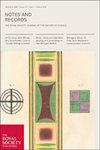十八世纪知识经济中的期望与效用
IF 0.6
3区 哲学
Q3 HISTORY & PHILOSOPHY OF SCIENCE
Notes and Records-The Royal Society Journal of the History of Science
Pub Date : 2018-04-18
DOI:10.1098/rsnr.2018.0004
引用次数: 0
摘要
为未来创建草图、计划或模型通常与努力预测其可能产生的结果密切相关。这也是一个稳定当代社会现实描述的过程,包括那些被理解为问题或需要改进的方面。正如Sang Hyun Kim和Sheila Jasanoff在他们关于“社会技术想象力”的工作中所表明的那样,计划和“科学和技术进步的愿景”经常充当沟通“公共目的”思想的工具,集体未来和共同利益。1未来的计划和粗略愿景本身就值得研究,即使它们从未实现,因为人们努力组织期望,并吸收关于什么是(和不是)符合他们声称代表的“公共利益”的想法。2关注未来设想的起源和引发期望的项目,即关注在漫长的18世纪可能实现或可能没有实现的“梦境”,是本特刊的一项主要任务。所有的文章都以这一时期想象中的未来为出发点,揭示了一系列不同的议程、道德要求和政治。事实上,十八世纪充满了梦幻。他们的创造者经常设计特定的类别和实践,以阐明他们想要或声称想要的未来,在某些情况下,还可以实际构建他们想要的未来。在这一时期的“知识经济”(这个术语现在通常与经济历史学家乔尔·莫基尔的工作联系在一起)中,梦境的制作者和未来的专业分析师通常被称为“投影仪”或“项目制作者”。3这种特殊的“梦景者”倾向于将他们的愿景锚定在草图、方案或改进计划中。Mokyr在戏剧性的…本文章由计算机程序翻译,如有差异,请以英文原文为准。
Expectations and utility in eighteenth-century knowledge economiesNotes and Records special issue introduction
Creating a sketch, a plan or a model for the future is often closely related to endeavouring to predict what it may yield. It is also a process that stabilizes contemporary portrayals of social realities, including those aspects understood as problems, or in need of improvement. As Sang-Hyun Kim and Sheila Jasanoff have shown in their work on ‘sociotechnical imaginaries’, frequently plans and ‘visions of scientific and technological progress’ act as vehicles for communicating ideas, implicitly and explicitly, about ‘public purposes, collective futures and the common good’ in a particular historical moment.1 Plans and sketchy visions for the future are worthy of study in their own right, even if they are never realized, because of the efforts to organize expectations and to assimilate ideas about what is (and is not) in the ‘public interest’ that they purport to represent.2 Attending to the origins and expectations inducing projects of envisioning the future, that is, attending to ‘dreamscapes’ that may or may not have been realized in the long eighteenth century, is a major task of this special issue. All of the essays take as their starting point that the imagined futures of this period reveal a distinct constellation of agendas, moral imperatives and politics.
Indeed, the eighteenth century was full of dreamscapes. Their makers routinely devised particular categories and practices to both articulate and, in some cases, to actually build the imagined futures they desired—or claimed to desire. In this period's ‘knowledge economy’, a term now generally associated with the work of economic historian Joel Mokyr, makers of dreamscapes and professional analysts of the future were often called ‘projectors’ or ‘project makers’.3 This particular cadre of ‘dreamscapers’ tended to anchor their visions in sketches, schemes or plans for improvement(s). Mokyr focused on the British context during the dramatic …
求助全文
通过发布文献求助,成功后即可免费获取论文全文。
去求助
来源期刊
CiteScore
1.50
自引率
0.00%
发文量
45
审稿时长
>12 weeks
期刊介绍:
Notes and Records is an international journal which publishes original research in the history of science, technology and medicine.
In addition to publishing peer-reviewed research articles in all areas of the history of science, technology and medicine, Notes and Records welcomes other forms of contribution including: research notes elucidating recent archival discoveries (in the collections of the Royal Society and elsewhere); news of research projects and online and other resources of interest to historians; essay reviews, on material relating primarily to the history of the Royal Society; and recollections or autobiographical accounts written by Fellows and others recording important moments in science from the recent past.

 求助内容:
求助内容: 应助结果提醒方式:
应助结果提醒方式:


